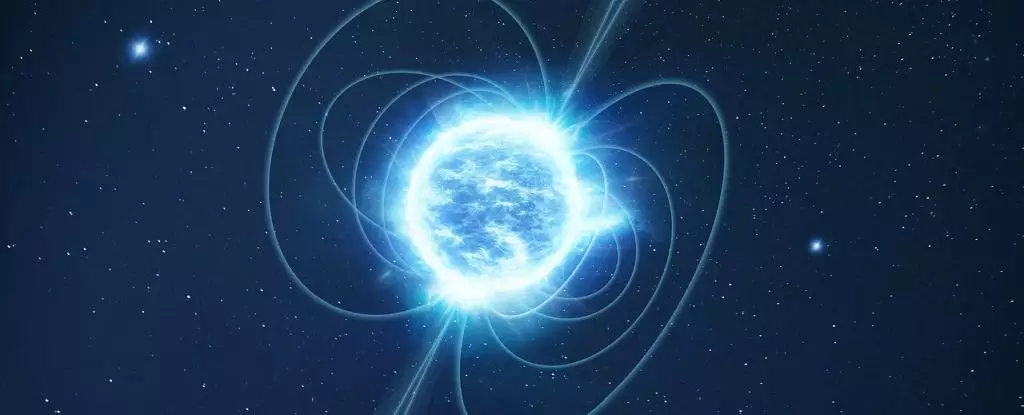In the vast expanse of our galaxy, certain celestial phenomena challenge our understanding of the universe, and among them stands the neutron star SGR 0501+4516, categorized as a magnetar. These extraordinary objects are defined by their extreme magnetic fields, which dwarf typical neutron stars, making them the most potent magnets known in the cosmos. Recent observations by the renowned Hubble and Gaia telescopes have revealed perplexing insights regarding the formation of SGR 0501+4516, leading astronomers to confront long-held assumptions about magnetars and their origins.
Magnetars are not merely extraordinary because of their magnetic pull; they represent a unique and elusive subset of neutron stars. Formed from the remnants of massive stars following the cataclysmic event of core-collapse supernovae, these stellar giants have puzzled scientists regarding their birth mechanisms. SGR 0501+4516, thought to be around 20,000 years old, has traditionally been linked to its proximity to a supernova remnant known as HB9. This relationship seemed to substantiate the belief that magnetars stem from such explosive deaths of massive stars.
Shifting Paradigms in Stellar Evolution
However, the collaborative research led by astronomer Ashley Chrimes from the European Space Agency has disrupted this tidy narrative. By utilizing precision parallax measurements from Gaia in conjunction with Hubble’s imaging capabilities, the team elucidated the motion and velocity of SGR 0501+4516 with astonishing accuracy. The findings indicated that the magnetar’s trajectory deviates from what would be expected if it were indeed associated with the HB9 remnant, undermining the core-collapse supernova hypothesis.
This surprising revelation has opened the door to alternative theories regarding the formation of SGR 0501+4516. If the magnetar is not a product of a supernova, then what explains its existence? One speculative pathway suggests that SGR 0501+4516 may have emerged from a merger event, perhaps involving low-mass neutron stars or even a white dwarf. In this scenario, a white dwarf—an aging star formed from the remnants of a lower-mass star—could potentially absorb excessive mass from a binary companion, leading to a gravitational collapse that births a neutron star.
The Role of Binary Systems in Stellar Birth
The implications of this theory are profound. Astronomers have long recognized the vital role of binary star systems in the life cycles of stars, particularly in scenarios involving their transformation through catastrophic events. In this context, a white dwarf that reaches critical mass does not simply explode; under specific conditions, it can collapse into a neutron star, engendering a new magnetic quantum of cosmic existence. This alternative pathway presents a significant shift in our understanding and highlights the complexities involved in stellar evolution.
The challenges in determining the precise origins of SGR 0501+4516 are underscored by the scarcity of magnetars within the Milky Way. With fewer than thirty known magnetars, SGR 0501+4516 stands out as a prime candidate challenging the conventional views on formation channels. Its unique characteristics redefine the narrative of how we conceive neutron stars and magnetars, pushing the boundaries of current astrophysical frameworks.
Cognitive Dissonance in the Face of Evidence
What remains truly fascinating is how these findings reflect a broader cognitive dissonance in the scientific community. While progress and discovery are commonly viewed as linear pathways to enlightenment, the reality is often fraught with ambiguity and unexpected twists. The case of SGR 0501+4516 exemplifies the perennial nature of scientific inquiry, where evidence accumulated over years can render previous theories obsolete. This realization showcases not only the resilience of scientific methodology but also its requirement for adaptability in the face of new data.
Moreover, the ongoing investigations into SGR 0501+4516 emphasize the need for sustained curiosity and skepticism within the scientific community. The narratives we craft about the universe must remain fluid, able to accommodate new insights and revelations. There is an inherent beauty in the unknown, a reminder that our quest to understand the cosmos will invariably lead us into uncharted territories, necessitating both humility and wonder.
The Allure of Future Discoveries
As astronomers continue to delve into the enigmatic realm of neutron stars and magnetars, it is evident that we are at the precipice of new celestial revelations. The intricate dance of gravity, magnetism, and stellar evolution is a testament to the universe’s complexity, echoing the idea that we are merely scratching the surface of cosmic understanding. Each discovery, including the peculiarities of SGR 0501+4516, ignites enthusiasm for further exploration and inquiry, fueling the relentless human spirit to uncover the mysterious layers of our galaxy.
In a universe filled with enigmas, SGR 0501+4516 serves as a potent reminder of the intricate narratives that weave together the fabric of astrophysics. As we unravel its secrets, we not only expand our knowledge of magnetars but also gain deeper insight into the nature of existence itself.


Leave a Reply